AMD Ryzen 5 5600X vs Intel Core i5-11600K: Mid-Range Rocket Lake and Ryzen 5000 CPU Face Off

The Intel Core i5-11600K vs AMD Ryzen 5 5600X rivalry is a heated battle for supremacy right in the heart of the mid-range CPU market. AMD's Ryzen 5000 processors took the lead in the desktop PC from Intel's competing Comet Lake processors last year, upsetting our Best CPU for gaming recommendations and our CPU Benchmarks hierarchy. Intel's response comes in the form of its Rocket Lake processors, which dial up the power to extreme levels and bring the new Cypress Cove architecture to the company's 14nm process as Intel looks to upset AMD's powerful Zen 3-powered Ryzen 5000 chips.
Intel has pushed its 14nm silicon to the limits as it attempts to unseat the AMD competition, and that has paid off in the mid-range where Intel's six-core Core i5-11600K weighs in with surprisingly good performance given its $232 to $262 price point.
Intel's aggressive pricing, and the fact that the potent Ryzen 5 5600X remains perpetually out of stock and price-gouged, has shifted the conversation entirely. For Intel, all it has to do is serve up solid pricing, have competitive performance, and make sure it has enough chips at retail to snatch away the win.
We put the Core i5-11600K up against the Ryzen 5 5600X in a six-round faceoff to see which chip takes the crown in our gaming and application benchmarks, along with other key criteria like power consumption and pricing. Let's see how the chips stack up.
Features and Specifications of AMD Ryzen 5 5600X vs Intel Core i5-11600K
| Header Cell - Column 0 | Suggested Price | Cores / Threads | Base (GHz) | Peak Boost (Dual/All Core) | TDP | iGPU | L3 |
|---|---|---|---|---|---|---|---|
| AMD Ryzen 5 5600X | $299 (and much higher) | 6 / 12 | 3.7 | 4.6 | 65W | None | 32MB (1x32) |
| Intel Core i5-11600K (KF) | $262 (K) - $237 (KF) | 6 / 12 | 3.9 | 4.6 / 4.9 (TB2) | 125W | UHD Graphics 750 Xe 32EU | 12MB |
The 7nm Ryzen 5 5600X set a new bar for the mid-range with six Zen 3 cores and twelve threads that operate at a 3.7-GHz base and 4.6-GHz boost frequency. Despite AMD's decision to hike gen-on-gen pricing, the 5600X delivered class-leading performance at its launch, not to mention a solid price-to-performance ratio. Things have changed since then, though, due to overwhelming demand coupled with pandemic-spurred supply chain disruptions, both of which have combined to make finding the Ryzen 5 5600X a rarity at retail, let alone at the suggested $299 pricing.
Intel's Core i5-11600K also comes with six cores and twelve threads, but Team Blue's chips come with the new Cypress Cove architecture paired with the aging 14nm process. Intel has tuned this chip for performance; it weighs in with a 3.9-GHz base, 4.9-GHz Turbo Boost 2.0, and 4.6-GHz all-core clock rates. All of these things come at the expense of power consumption and heat generation.
Intel specs the 14nm 11600K at a 125W TDP rating, but that jumps to 182W under heavy loads, while AMD's denser and more efficient 7nm process grants the 5600X a much-friendlier 65W TDP rating that coincides with a peak of 88W. We'll dive deeper into power consumption a bit later, but this is important because the Core i5-11600K comes without a cooler. You'll need a capable cooler, preferably a 280mm liquid AIO or equivalent air cooler, to unlock the best of the 11600K.
Meanwhile, the AMD Ryzen 5 5600X comes with a bundled cooler that is sufficient for most users, though you would definitely need to upgrade to a better cooler if you plan on overclocking. Additionally, a more robust cooler will unlock slightly higher performance in heavy work, like rendering or encoding. Still, you'd need to do that type of work quite regularly to see a worthwhile benefit, so most users will be fine with the bundled cooler.
Both the Core i5-11600K and Ryzen 5 5600X support PCIe 4.0, though it is noteworthy that Intel's chipset doesn't support the speedier interface. Instead, devices connected to Intel's chipset operate at PCIe 3.0 speeds. That means you'll only have support for one PCIe 4.0 m.2 SSD port on your motherboard, whereas AMD's chipset is fully enabled for PCIe 4.0, giving you more options for a plethora of faster devices.
Both chips also support two channels of DDR4-3200 memory, but Intel's new Gear memory feature takes a bit of the shine off Intel's memory support. At stock settings, the 11600K supports DDR4-2933 in Gear 1 mode, which provides the best latency and performance for most tasks, like gaming. You'll have to operate the chip in Gear 2 mode for warrantied DDR4-3200 support, but that results in performance penalties in some latency-sensitive apps, like gaming, which you can read about here.
For some users, the 11600K does have a big insurmountable advantage over the Ryzen 5 5600X: The chip comes with the new UHD Graphics 750 comes armed with 32 EUs based on the Xe graphics engine, while all Ryzen 5000 processors come without integrated graphics. That means Intel wins by default if you don't plan on using a discrete GPU.
Notably, you could also buy Intel's i5-11600KF, which comes with a disabled graphics engine, for $25 less. At $237, the 11600KF looks incredibly tempting, which we'll get to a bit later.
Winner: AMD
The Ryzen 5 5600X and the Core i5-11600K are close with six cores and twelve threads (and each of those cores has comparable performance), but the 5600X gets the nod here due to its bundled cooler and native support for DDR4-3200 memory. Meanwhile, the Core i5-11600K comes without a cooler, and you'll have to operate the memory in sub-optimal Gear 2 mode to access DDR4-3200 speeds, at least if you want to stay within the warranty.
The Core i5-11600K comes with integrated graphics, so it wins by default if you don't plan on using a discrete GPU. Conversely, you can sacrifice the graphics for a lower price point. AMD has no high-end chips that come with integrated graphics, though that will change by the end of the year when the Ryzen 5000 Cezanne APUs arrive.
Gaming Performance on AMD Ryzen 5 5600X vs Core i9-11600K
The Ryzen 5 and Core i5 families tend to be the most popular gaming chips, and given the big architectural advances we've seen with both the Zen 3 and Cypress Cove architectures, these mid-range processors can push fast GPUs along quite nicely.
That said, as per usual, we're testing with an Nvidia GeForce RTX 3090 to reduce GPU-imposed bottlenecks as much as possible, and differences between test subjects will shrink with lesser cards, which you'll see most often with this class of chip, or higher resolutions. Below you can see the geometric mean of our gaming tests at 1080p and 1440p, with each resolution split into its own chart. PBO indicates an overclocked Ryzen configuration. You can find our test system details here.











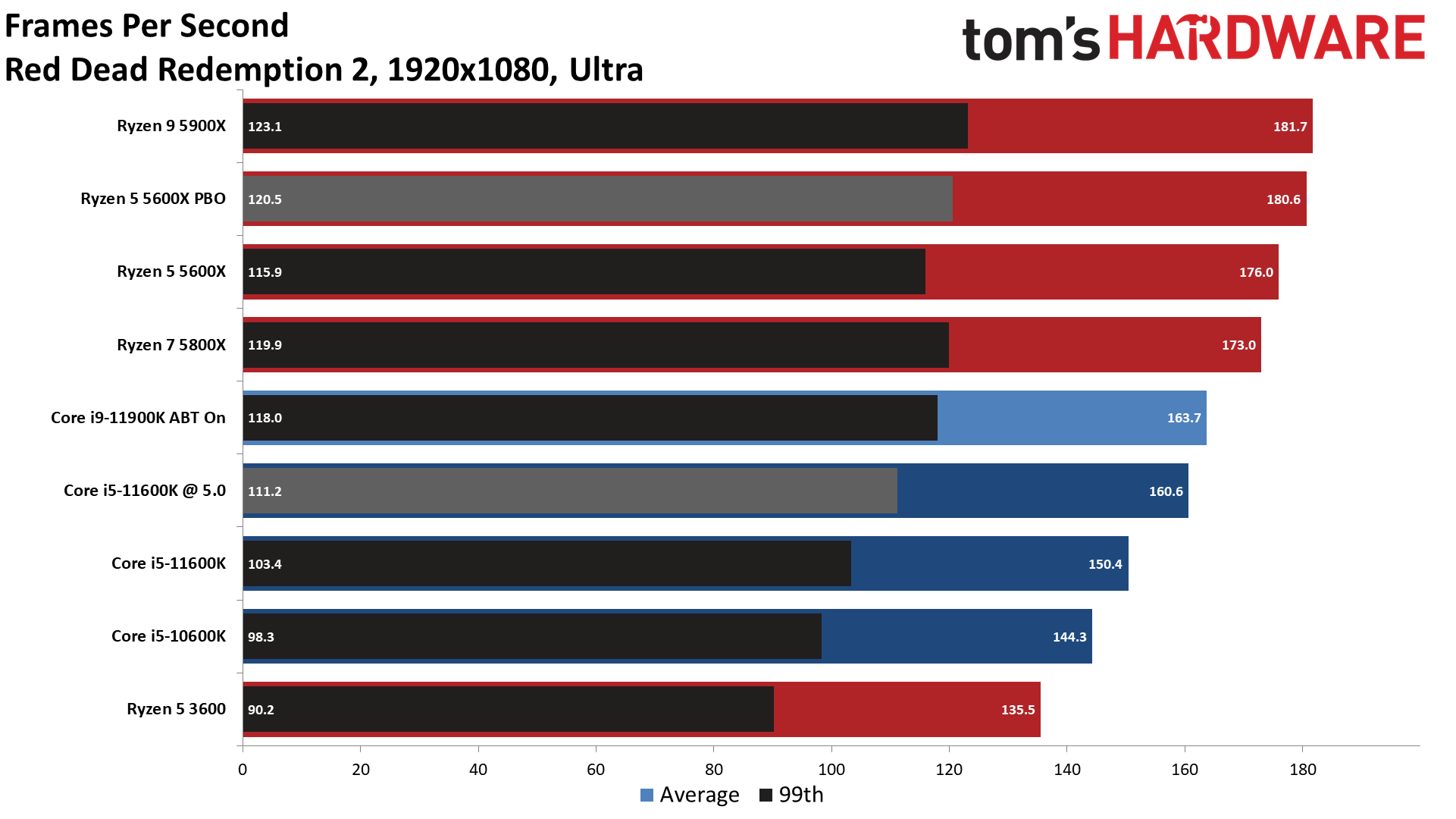




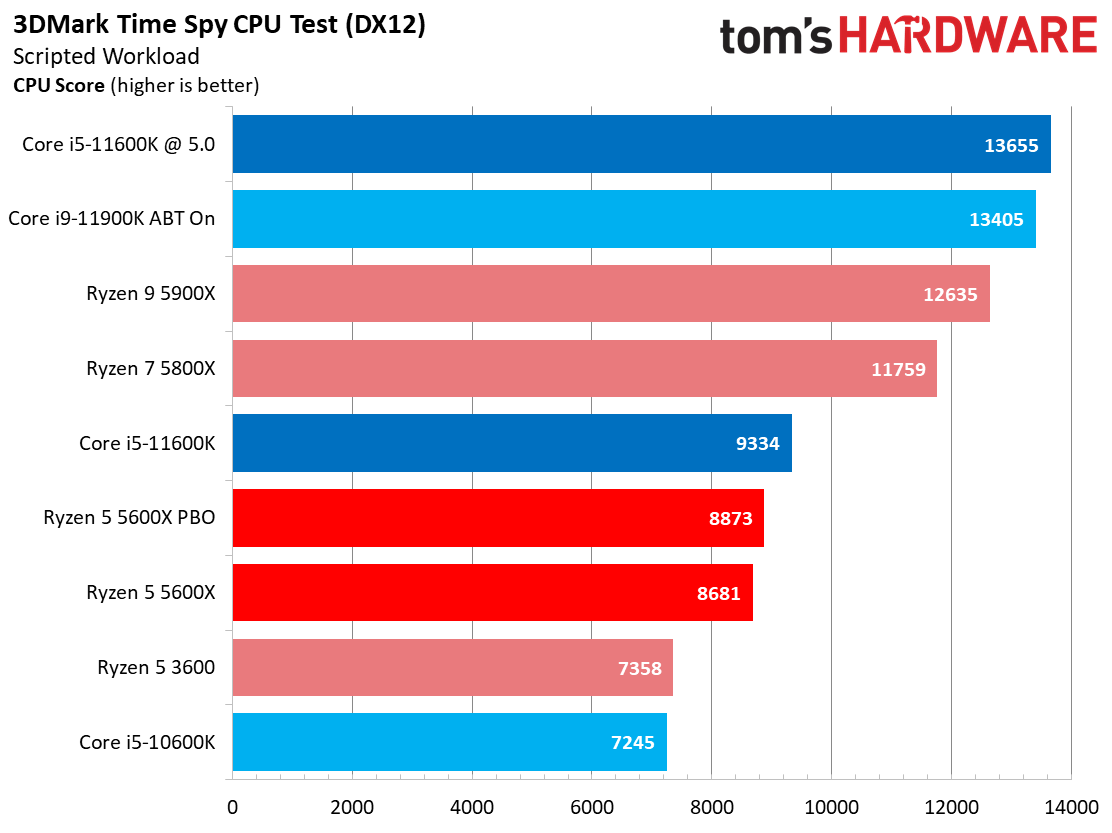

At stock settings at 1080p, the Core i5-11600K notches an impressive boost over its predecessor, the 10600K, but the Ryzen 5 5600X is 7.8% faster over the full span of our test suite. Overclocking the 11600K brings it up to snuff with the stock Ryzen 5 5600X, but the overclocked 5600X configuration is still 3.6% faster.
As you would expect, those deltas will shrink tremendously with lesser graphics cards or with higher resolutions. At 1440p, the stock 5600X is 3.3% faster than the 11600K, and the two tie after overclocking.
Flipping through the individual games shows that the leader can change quite dramatically, with different titles responding better to either Intel or AMD. Our geometric mean of the entire test suite helps smooth that out to one digestible number, but bear in mind – the faster chip will vary based on the game you play.
Notably, the 11600K is 14% less expensive than the 5600X, and that's if (a huge if) you can find the 5600X at recommended pricing. You could also opt for the graphics-less 11600KF model and pay 26% less than the 5600X, again, if you can find the 5600X at recommended pricing.
Winner: AMD
Overall, the Ryzen 5 5600X is the faster gaming chip throughout our test suite, but be aware that performance will vary based on the title you play. This class of chips is often paired with lesser graphics cards, and most serious gamers play at higher resolutions. In both of those situations, you could be hard-pressed to notice the difference between the processors. However, it's rational to expect that the Ryzen 5 5600X will leave a bit more gas in the tank for future GPU upgrades.
Get Tom's Hardware's best news and in-depth reviews, straight to your inbox.
Pricing is the wild card, though, and the Core i5-11600K wins that category easily — even if you could find the Ryzen 5 5600X at suggested pricing. We'll dive into that in the pricing section.
Application Performance of Intel Core i5-11600K vs Ryzen 5 5600X











We can boil down productivity application performance into two broad categories: single- and multi-threaded. The first slide in the above album has a geometric mean of performance in several of our single-threaded tests, but as with all cumulative measurements, use this as a general guide and be aware that performance will vary based on workload.
The Core i5-11600K takes the lead, at both stock and overclocked settings, by 3.8% and 1%, respectively. These are rather slim deltas, but it's clear that the Rocket Lake chip holds the edge in lightly threaded work, particularly in our browser tests, which are a good indicator of general snappiness in a standard desktop PC operating system. We also see a bruising performance advantage in the single-threaded AVX-512-enabled y-cruncher.
The Core i5-11600K is impressive in single-threaded work, but the Ryzen 5 5600X isn't far behind. It's too bad that the 11600K's lead in these types of tests doesn't equate to leading performance in gaming, which has historically been the case with processors that excel at single-threaded tasks.





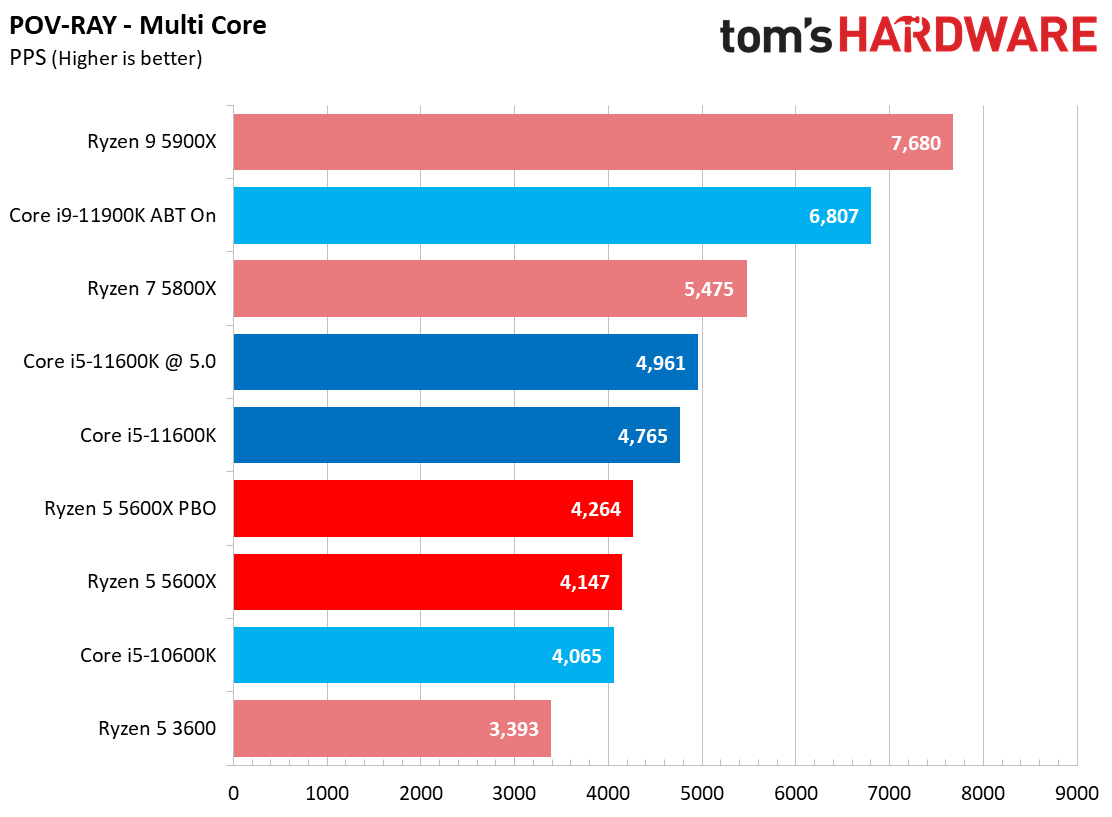






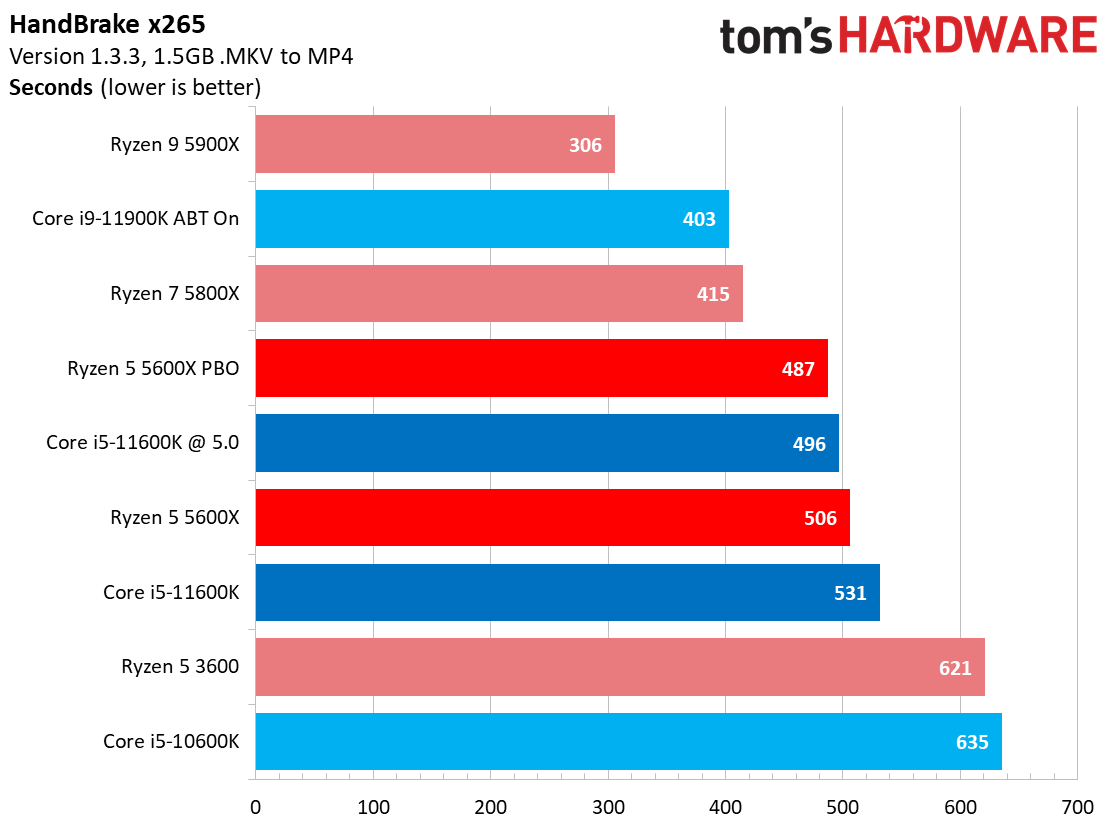








Here we take a closer look at performance in heavily-threaded applications, which has long been the stomping grounds of AMD's core-heavy Ryzen processors. Surprisingly, in our cumulative measurement, the Core i5-11600K is actually 2.5% faster than the 5600X at stock settings and is 1.8% faster after we overclocked both chips.
These are, again, slim deltas, and the difference between the chips will vary based on workload. However, the Core i5-11600K is very competitive in threaded work against the 5600X, which is an accomplishment in its own right. The substantially lower pricing is even more impressive.
Winner: Intel
Based on our cumulative measurement, Intel's Core i5-11600K comes out on top in both single- and multi-threaded workloads, but by slim margins in both categories of workloads, and that can vary based on the application. However, given that the Core i5-11600K has significantly lower pricing and pulls out a few hard-earned wins on the application front, this category of the Core i5-11600K vs Ryzen 5 5600X competition goes to Intel.
Overclocking of Ryzen 5 5600X vs Core i5-11600K
We have reached the land of diminishing returns for overclocking the highest-end chips from both AMD and Intel, largely because both companies are engaged in a heated dogfight for performance superiority. As a result, much of the overclocking frequency headroom is rolled into standard stock performance, leaving little room for tuners, making memory and fabric overclocking all the more important. There's still plenty of advantages with overclocking the midrange models though in today's Ryzen 5 5600X vs Core i5-11600K battle, but be aware that your mileage may vary.
Intel benefits from higher attainable clock rates, especially if you focus on overclocking a few cores instead of the standard all-core overclock, and exposes a wealth of tunable parameters with its Rocket Lake chips. That includes separate AVX offsets for all three flavors of AVX, and the ability to set voltage guardbands. Intel also added an option to completely disable AVX, though that feature is primarily geared for professional overclockers. Rocket also supports per-core frequency and hyper-threading control (enable/disable) to help eke out more overclocking headroom.
The Core i5-11600K supports real-time memory frequency adjustments, though motherboard support will vary. For example, this feature allows you to shift from DDR4-2933 to DDR4-3200 from within Windows 10 without rebooting (or any other attainable memory frequency). Intel also supports live memory timing adjustments from within the operating system.
Intel has long locked overclocking to its pricey K-series models, while AMD freely allows overclocking with all SKUs on almost any platform. However, we see signs of some improvement here from Intel, as it has now enabled memory overclocking on its B560 and H570 chipsets across the board. That said, Intel's new paradigm of Gear 1 and Gear 2 modes does reduce the value of memory overclocking, which you can read more about in our review.
AMD's Ryzen 5000 chips come with innovative boost technology that largely consumes most of the available frequency headroom, so there is precious little room for bleeding-edge all-core overclocks. In fact, all-core overclocking with AMD's chips is lackluster; you're often better off using its auto-overclocking Precision Boost Overdrive 2 (PBO2) feature that boosts multi-threaded performance. AMD also has plenty of Curve Optimization features that leverage undervolting to increase boost activity.
Much of the benefit of the Ryzen 500 series0 comes from its improved fabric overclocking, which then allows you to tune in higher memory overclocks. We hit a 1900-MHz fabric on our chip, allowing us to run the memory in a 1:1 mode at a higher DDR4-3800 memory speed than we could pull off with the 11600K with the same 1:1 ratio. It also isn't uncommon to see enthusiasts hit DDR4-4000 in 1:1 mode with Ryzen 5000 processors. There's no doubt that Intel's new Gear 1 and 2 memory setup isn't that refined — you can adjust the 5600X's fabric ratio to expand the 1:1 window to higher frequencies, while Intel does not have a comparable adjustable parameter.
Winner: Tie
Both the Ryzen 5 5600X and the Core i5-11600K have a bit more overclocking headroom than their higher-end counterparts, meaning that there is still some room for gains in the mid-range. Both platforms have their respective overclocking advantages and a suite of both auto-overclocking and software utilities, meaning this contest will often boil down to personal preference.
Power Consumption, Efficiency, and Cooling of Intel Core i5-11600K vs AMD Ryzen 5 5600X




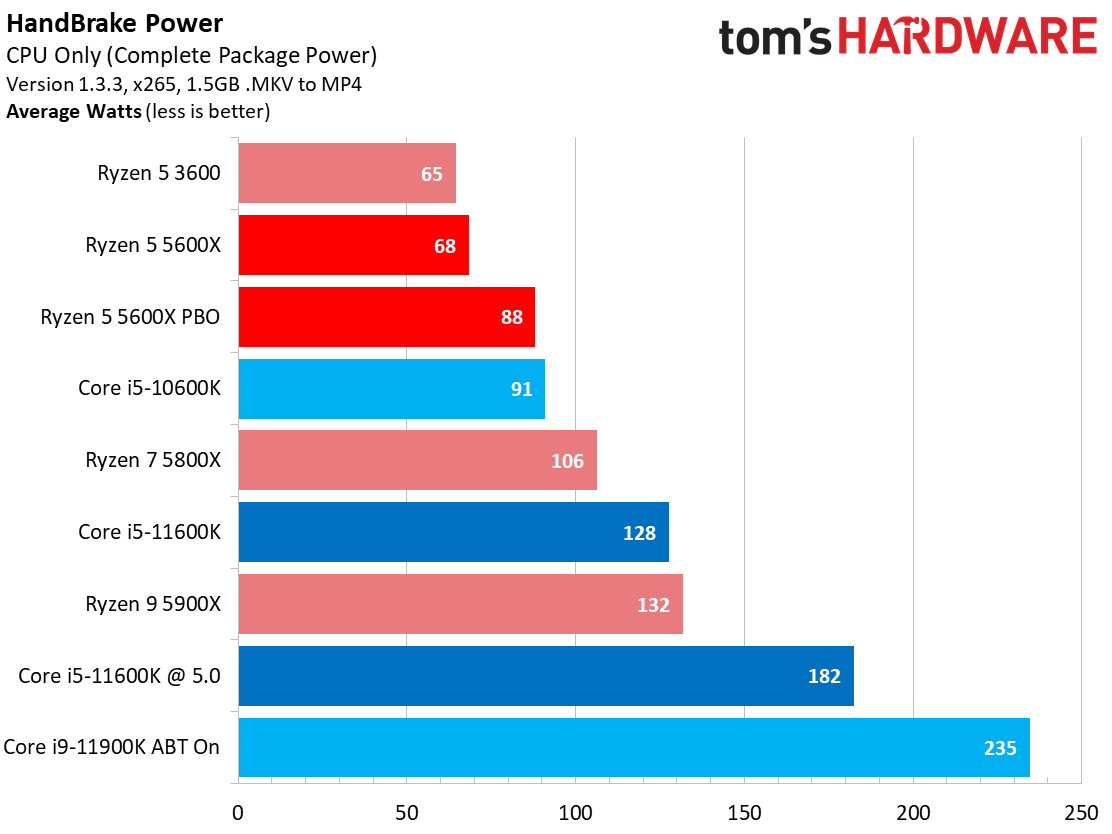







The Core i5-11600K comes with the same 125W TDP rating as its predecessor, but that rating is a rough approximation of power consumption during long-duration workloads. To improve performance in shorter-term workloads, Intel increased the PL2 rating (boost) to 251W, a whopping 69W increase over the previous-gen 10600K that also came with six cores.
Power consumption and heat go hand in hand, so you'll have to accommodate that power consumption with a robust cooler. We didn't have any issues with the Core i5-11600K and a 280mm liquid cooler (you could get away with less), but we did log up to 176W of power consumption at stock settings during our Handbrake benchmark.
In contrast, the Ryzen 5 5600X sips power, reaching a maximum of 76W at stock settings during a Blender benchmark. In fact, a quick look at the renders-per-day charts reveals that AMD's Ryzen 5 5600X is in another league in terms of power efficiency — you get far more performance per watt consumed, which results in lower power consumption and heat generation.
The 5600X's refined power consumption comes via TSMC's 7nm process, while Intel's 14nm process has obviously reached the end of the road in terms of absolute performance and efficiency.
Winner: AMD
AMD wins this round easily with lower power consumption, higher efficiency, and less thermal output. Intel has turned the power up to the extreme to stay competitive with AMD's 7nm Ryzen 5000 chips, and as a result, the Core i5-11600K pulls more power and generates more heat than the Ryzen 5 5600X. Additionally, the Core i5-11600K doesn't come with a bundled cooler, so you'll need to budget in a capable model to unlock the best the chip has to offer, while the Ryzen 5 5600X comes with a bundled cooler that is good enough for the majority of users.
Pricing and Value of AMD Ryzen 5 5600X vs Intel Core i5-11600K
AMD was already riding the pricing line with the Ryzen 5 5600X's suggested $299 price tag, but supply of this chip is volatile as of the time of writing, to put it lightly, leading to price gouging. This high pricing comes as a byproduct of a combination of unprecedented demand and pandemic-spurred supply chain issues, but it certainly destroys the value proposition of the Ryzen 5 5600X, at least for now.
The Ryzen 5 5600X currently retails for $370 at Microcenter, which is usually the most price-friendly vendor, a $69 markup over suggested pricing. The 5600X is also $450 from Amazon (not a third-party seller). Be aware that the pricing and availability of these chips can change drastically in very short periods of time, and they go in and out of stock frequently, reducing the accuracy of many price tracking tools.
In contrast, the Core i5-11600K can be found for $264 at Amazon, and $260 at Microcenter, which is surprisingly close to the $262 suggested tray pricing. Additionally, you could opt for the graphics-less Core i5-11600KF if you don't need a discrete GPU. That chip is a bit harder to find than the widely-available 11600K, but we did find it for $240 at Adorama (near suggested pricing).
Here's the breakdown (naturally, this will vary):
| Header Cell - Column 0 | Suggested Price | Current (volatile for 5600X) | Price Per Core |
|---|---|---|---|
| Core i5-11600K | $262 | $262 to $264 | ~$32.75 |
| Ryzen 5 5600X | $299 | $370 to $450 | ~$46.25 to $56.25 |
| Core i5-11600KF | $237 | $240 (spotty availability) | ~$29.65 |
The Core i5-11600K doesn't come with a cooler, so you'll have to budget that into your purchasing decision.
Winner: Intel
Even at recommended pricing for both chips, Intel's aggressive pricing makes the Core i5-11600K a tempting proposition, but the company wins this stage of the battle convincingly based on one almost insurmountable advantage: You can actually find the chip readily available at retail for very close to its suggested tray pricing. With much cheaper pricing both on a per-core and absolute basis, the Core i5-11600K is the better buy, and if you're looking for an even lower cost of entry, the Core i5-11600KF is plenty attractive if you don't need integrated graphics.
AMD's premium pricing for the Ryzen 5 5600X was a bit of a disappointment for AMD fans at launch, but the chip did offer enough advantages to justify the price tag. However, the arrival of the Core i5-11600K with its disruptive pricing and good-enough performance would probably merit a slight pricing adjustment from AMD, or the release of a non-X model, if these were normal times. These aren't normal times, though, and instead of being able to improve its value proposition, AMD faces crippling supply challenges.
Bottom Line
| Header Cell - Column 0 | Intel Core i5-11600K | AMD Ryzen 5 5600X |
|---|---|---|
| Features and Specifications | Row 0 - Cell 1 | X |
| Gaming | Row 1 - Cell 1 | X |
| Application Performance | X | Row 2 - Cell 2 |
| Overclocking | X | X |
| Power Consumption, Efficiency, and Cooling | Row 4 - Cell 1 | X |
| Pricing and Value Proposition | X | Row 5 - Cell 2 |
| Total | 3 | 4 |
Here's the tale of the tape: AMD wins this Ryzen 5 5600X vs Intel Core i5-11600K battle with a tie in one category and a win in three others, marking a four to three victory in favor of Team Red. Overall, the Ryzen 5 5600X offers up a superior blend of gaming performance, power consumption and efficiency, and a bundled cooler to help offset the higher suggested retail pricing, remaining our go-to chip recommendation for the mid-range. That is if you can find it at or near suggested pricing.
Unfortunately, in these times of almost unimaginably bad chip shortages, the chip that you can actually buy, or even find anywhere even near recommended pricing, is going to win the war at the checkout lane. For now, Intel appears to be winning the supply battle, though that could change in the coming months. As a result, the six-core twelve-thread Core i5-11600K lands with a friendly $262 price point, making it much more competitive with AMD's $300 Ryzen 5 5600X that currently sells far over suggested pricing due to shortages.
The Core i5-11600K has a very competitive price-to-performance ratio compared to the Ryzen 5 5600X in a broad swath of games and applications. The 11600K serves up quite a bit of performance for a ~$262 chip, and the graphics-less 11600KF is an absolute steal if you can find it near the $237 tray pricing. If you don't need an integrated GPU, the KF model is your chip.
Even if we compare the chips at AMD's and Intel's standard pricing, the Core i5-11600K is a potent challenger with a solid value proposition due to its incredibly aggressive pricing. While the Core i5-11600K might not claim absolute supremacy, its mixture of price and performance makes it a solid buy if you're willing to overlook the higher power consumption.
Most gamers would be hard-pressed to notice the difference when you pair these chips with lesser GPUs or play at higher resolutions, though the Ryzen 5 5600X will potentially leave you with more gas in the tank for future GPU upgrades. The Ryzen 5 5600X is the absolute winner, though, provided you can find it anywhere close to the suggested retail price.

Paul Alcorn is the Editor-in-Chief for Tom's Hardware US. He also writes news and reviews on CPUs, storage, and enterprise hardware.
-
JayNor "you'll only have support for one PCIe 4.0 m.2 SSD port on your motherboard"Reply
I believe the Rocket Lake chips have 20 pcie 4.0 lanes from the CPU... apparently usually allocated as 16 for a GPU and 4 for the m.2 slot, right? That was stated in a prior tomshardware article and elsewhere.
https://www.tomshardware.com/news/intel-11th-gen-rocket-lake-s-specifications-pricing
"Rocket's internal PCIe subsystem to accommodate a direct x4 connection for M.2 SSDs and a x16 graphics connection to the CPU (the chips now support 20 lanes of PCIe 4.0)." -
JayNor From other 5600x descriptions, the AMD 5000 family has 24 pcie4 lanes, but 4 of them are used for connection to the chipset ... leaving 20 pcie4 lanes available, same as on Rocket Lake, right? See this article, for example:Reply
https://www.guru3d.com/articles-pages/amd-ryzen-5-5600x-review,3.html
"Ryzen 5000 CPUs will have a total of 24 PCIe Gen4 lanes. Four out of the twenty-four are used for the interconnect to the motherboard chipset, leaving 20 lanes Gen 4.0 for other utilization." -
jgraham11 You realize your statement regarding overclocking, more specifically not being able to cool the 5600X with the cooler provided is wrong. By Tom's own numbers: PBO only draws 88WattsReply
Also your statement of price advantage is gone once you factor that the $260 Intel CPU needs a $50 cooler while the $300 AMD one does not.
Bottom line who would want a CPU that runs so hot, it means you have to buy a more expensive MB that has better power delivery and a larger Power supply which negates any price advantage it has. -
JayNor Replyjgraham11 said:
Also your statement of price advantage is gone once you factor that the $260 Intel CPU needs a $50 cooler while the $300 AMD one does not.
Rocket Lake's integrated GPU and display support for three screens at 4K60 looks like a good setup for a business desktop. -
hotaru251 shouldnt things like each systems specs be listed somewhere?Reply
pushing each system to a stable OC (you know what most ppl who care about performance would usually do and as a result of OC match each ones cooler to same one?)
nobody buys a K sku to not oc it. and ryzen gets its best uplift from ocing it and messing with timings.
not saying intel is bad but just questionable when they arent at the peak of what they each offer. -
Paul Alcorn Replyhotaru251 said:shouldnt things like each systems specs be listed somewhere?
pushing each system to a stable OC (you know what most ppl who care about performance would usually do and as a result of OC match each ones cooler to same one?)
nobody buys a K sku to not oc it. and ryzen gets its best uplift from ocing it and messing with timings.
not saying intel is bad but just questionable when they arent at the peak of what they each offer.
We link to the review which has the system specs listed for each setup. They are both tested with same cooler for OC. -
Paul Alcorn ReplyJayNor said:From other 5600x descriptions, the AMD 5000 family has 24 pcie4 lanes, but 4 of them are used for connection to the chipset ... leaving 20 pcie4 lanes available, same as on Rocket Lake, right? See this article, for example:
https://www.guru3d.com/articles-pages/amd-ryzen-5-5600x-review,3.html
"Ryzen 5000 CPUs will have a total of 24 PCIe Gen4 lanes. Four out of the twenty-four are used for the interconnect to the motherboard chipset, leaving 20 lanes Gen 4.0 for other utilization."
Intel chipset is pcie 3.0, not 4.0. -
Why_Me Reply
https://wccftech.com/z590-motherboards-pcie-gen-4-0-compatibility-intel-rocket-lake-core-i9-i7-i5-cpus/PaulAlcorn said:Intel chipset is pcie 3.0, not 4.0. -
Paul Alcorn ReplyWhy_Me said:https://wccftech.com/z590-motherboards-pcie-gen-4-0-compatibility-intel-rocket-lake-core-i9-i7-i5-cpus/
The 500-series chipset, specifically, does not support PCIe 4.0 in any fashion, and that is direct from Intel. No connection to or from that chipset operates at 4.0, under any circumstances. I haven't read the linked article, but I believe it refers to CPU support. -
dcbohn2016 Not to be a wet blanket but the rarity of the 5600X seems to be overstated! My local Micro C has had plenty since Febuaray. I bought one for list at then end of last month and was unhappy that it is in stock and $10 below list today. I have also seem them in newegg's daily sales ads.Reply